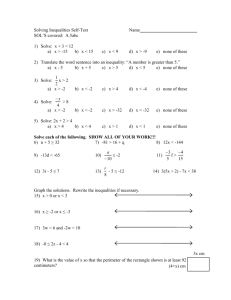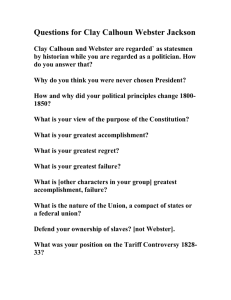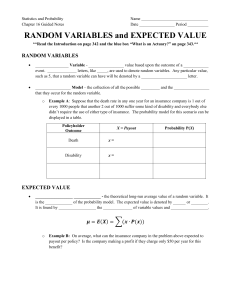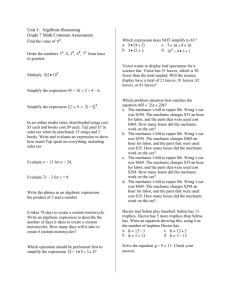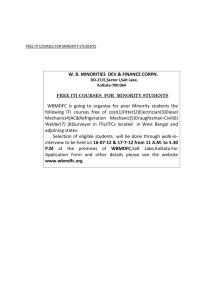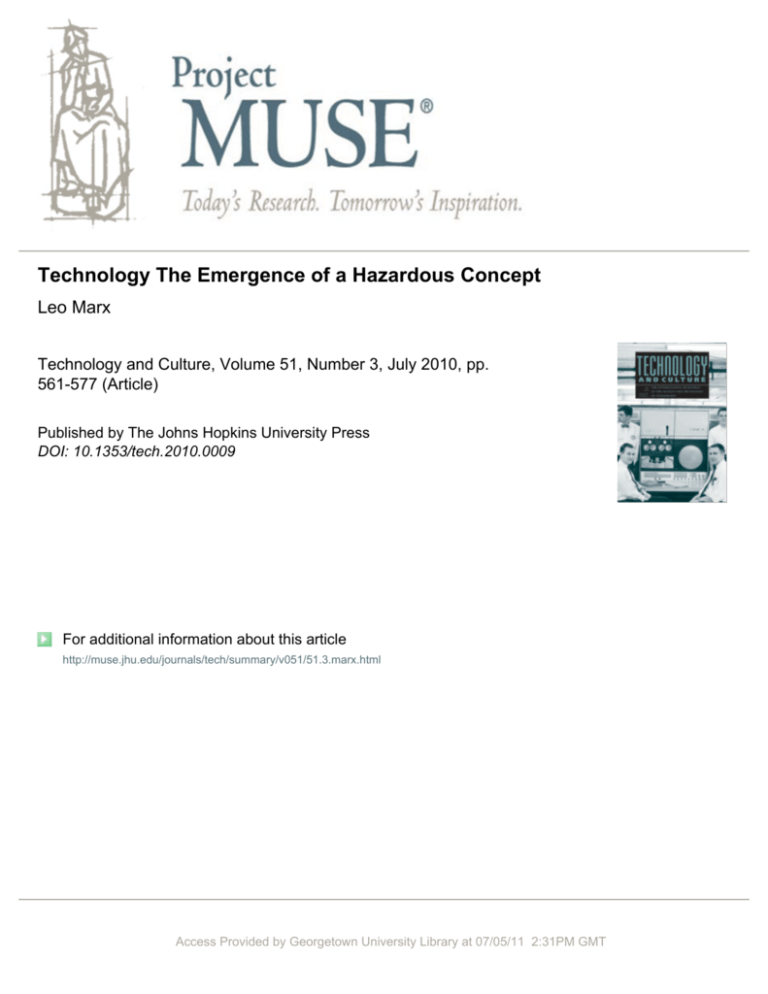
Technology The Emergence of a Hazardous Concept
Leo Marx
Technology and Culture, Volume 51, Number 3, July 2010, pp.
561-577 (Article)
Published by The Johns Hopkins University Press
DOI: 10.1353/tech.2010.0009
For additional information about this article
http://muse.jhu.edu/journals/tech/summary/v051/51.3.marx.html
Access Provided by Georgetown University Library at 07/05/11 2:31PM GMT
01_51.3marx 561–77:03_49.3dobraszczyk 568–
7/14/10
12:40 PM
Page 561
E S S AY S
Technology
The Emergence of a Hazardous Concept
LEO MARX
“. . . the essence of technology is by no means anything technological.”
— Martin Heidegger1
New Concepts as Historical Markers
The history of technology is one of those subjects that most people know
more about than they realize. Long before the academy recognized it as a
specialized field of scholarly inquiry, American schools were routinely disseminating a sketchy outline of that history to millions of pupils. We learned
about James Watt and the steam engine, Eli Whitney and the cotton gin, and
about other great inventors and their inventions. Even more important, we
were led to assume that innovation in the mechanic arts is a—perhaps the—
driving force of human history. The theme was omnipresent in my childhood experience. I met it in the graphic charts and illustrations in my copy
of The Book of Knowledge, a popular children’s encyclopedia, and in the
alluring dioramas of Early Man in the New York Museum of Natural History. These exhibits represented the advance of civilization as a sequence of
the inventions in the mechanic arts with which Homo sapiens gained a
unique power over nature. This comforting theme remains popular today
and is insinuated by all kinds of historical narrative. Here, for example, is a
passage from an anthropological study of apes and the origins of human
violence:
Leo Marx is Senior Lecturer and William R. Kenan Professor of American Cultural History Emeritus in the Program in Science, Technology, and Society at the Massachusetts
Institute of Technology. An early version of this essay was delivered as the Richmond
Lecture at Williams College, 26 September 1996, also published in Social Research 64 (fall
1997): 965–88 (thanks to Social Research, www.socres.org, for allowing Technology and
Culture to publish this revision).
©2010 by the Society for the History of Technology. All rights reserved.
0040-165X/10/5103-0001/561–77
1. Martin Heidegger, The Question Concerning Technology and Other Essays, trans.
William Lovett (New York, 1977), 4.
561
01_51.3marx 561–77:03_49.3dobraszczyk 568–
T E C H N O L O G Y
VOL. 51
12:40 PM
Page 562
C U LT U R E
Our own ancestors from this line [of woodland apes] began shaping
stone tools and relying much more consistently on meat around 2
million years ago. They tamed fire perhaps 1.5 million years ago.
They developed human language at some unknown later time, perhaps 150,000 years ago. They invented agriculture 10,000 years ago.
They made gunpowder around 1,000 years ago, and motor vehicles
a century ago.2
JULY
2010
A N D
7/14/10
This typical summary of human history from stone age tools to Ford
cars illustrates the shared “scientific” understanding, circa 2010, of the history of technology. But one arresting if scarcely noted aspect of the story is
the belated emergence of the word used to name the very rubric—the kind
of thing—that allegedly drives our history. The word is technology. The fact
is that during all but the very last few seconds, as it were, of the ten millennia of recorded human history encapsulated in this account, the concept of
technology—as we know it today—did not exist. The word technology,
which joined the Greek root, techne (an art or craft) with the suffix ology (a
branch of learning), first entered the English language in the seventeenth
century. At that time, in keeping with its etymology, a technology was a
branch of learning, or discourse, or treatise concerned with the mechanic
arts. As Eric Schatzberg has demonstrated in a seminal essay, the word then
referred to a field of study, not an object of study.3 But the word, even in
that now archaic sense, was a rarity in nineteenth-century America. By
1861, to be sure, it was accorded a somewhat greater prominence by the
founders of the Massachusetts Institute of Technology, but they also were
invoking the limited sense of the term to mean higher technical education.
As for technology in the now familiar sense of the word—the mechanic arts
collectively—it did not catch on in America until around 1900, when a few
influential writers, notably Thorstein Veblen and Charles Beard, responding to German usage in the social sciences, accorded technology a pivotal
role in shaping modern industrial society. But even then, the use of the
word remained largely confined to academic and intellectual circles; it did
not gain truly popular currency until the 1930s.
But why, one might ask, is the history of this word important? The
answer, from the viewpoint of a cultural historian, is that the emergence of
a keyword in public discourse—whether a newly coined word or an old
2. Richard Wrangham and Dale Peterson, Demonic Males: Apes and the Origins of
Human Violence (New York, 1996), 61.
3. Erik Schatzberg, “Technik Comes to America: Changing Meanings of Technology
before 1930,” Technology and Culture 47 (2006): 486–512. The first use of the amplified
sense of the word, referring to the mechanic arts themselves, according to the Oxford
English Dictionary (OED), was in 1859; variants of the older meaning of technology—
e.g., technik, technique, etc.—also had appeared in German, Swedish, French, and
Spanish in the late eighteenth century.
562
01_51.3marx 561–77:03_49.3dobraszczyk 568–
7/14/10
12:40 PM
Page 563
MARXK|KTechnology: The Emergence of a Hazardous Concept
word invested with new meaning—may prove to be an illuminating historical event. Such keywords often serve as markers, or chronological signposts, of subtle, virtually unremarked, yet ultimately far-reaching changes
in culture and society. Recall, for example, Tocqueville’s tacit admission, in
Democracy in America, that in order to do his subject justice he was compelled to coin the (French) word individualisme, “a novel expression to
which a novel idea has given birth”; or Raymond Williams’s famous discovery, in writing Culture and Society, of the striking interdependence (or
reflexivity) in the relations between certain keywords and fundamental
changes in society and culture. Williams had set out to examine the transformation of culture coincident with the advent of industrial capitalism in
Britain, but he found that the concept of culture itself, along with such
other pivotal concepts of the era as class, industry, democracy, and art, was
a product of—indeed had been invested with its new meaning by—the very
changes he proposed to analyze. Not only had those changes lent currency
to the concept of culture, but they had simultaneously changed its meaning.
I believe that a similar process marked the emergence of technology as a keyword in the lexicon we rely on to chart the changing character of contemporary society and culture.4
But how, then, are we to identify the specific changes that prompted the
emergence of technology—the concept, the word, the purported thing
itself? My assumption is that those changes, whatever they were, created a
semantic—indeed, a conceptual—void, which is to say, an awareness of certain novel developments in society and culture for which no adequate
name had yet become available. It was this void, presumably, that the word
technology, in its new and extended meaning, eventually would fill. It would
prove to be preferable—a more apt signifier—for the new agents of change
than any of its precursors, received terms such as the mechanic (or useful or
practical or industrial) arts, or invention, improvement, machine, machinery,
or mechanism. In a seminal essay of 1829, Thomas Carlyle had posed a variant of my question: if one had to sum up the oncoming age in a word, he
asked, what might it be? His unequivocal answer was: machinery. “It is the
Age of Machinery,” he wrote, “in every outward and inward sense of that
word.”5 During the next half century, however, machinery—like the alternatives just mentioned—turned out to be unsuitable. But why? Why did
technology prove to be preferable? To answer the question, we need to iden4. Alexis de Tocqueville, Democracy in America, trans. Phillips Bradley (New York,
1946), II:98 (the OED credits the Henry Reeve translation of 1835 with the first use of
the word in English); Raymond Williams, Culture and Society, 1780–1950 (New York:
1983), xiii–xviii; Keywords: A Vocabulary of Culture and Society (New York, 1985), 11–26
and 315–16.
5. Thomas Carlyle, “Signs of the Times,” Edinburgh Review (1829), reprinted in
Selected Writings, ed. Alan Shelston (New York, 1971), 64. Carlyle, incidentally, is credited
with the first use of the word industrialism, in Sartor Resartus (1831).
563
ESSAYS
01_51.3marx 561–77:03_49.3dobraszczyk 568–
T E C H N O L O G Y
JULY
2010
VOL. 51
A N D
7/14/10
12:40 PM
Page 564
C U LT U R E
tify the specific character of the concurrent changes in the mechanic arts—
not only the changes within those arts, but also the changes in the interrelations between them and the rest of society and culture.
As for the hazardous character of the concept of technology, here I need
only say that I am not thinking about weaponry or the physical damage
wrought by the use of any particular technologies. The hazards I have in
mind are conceptual, not physical. They stem from the meanings conveyed
by the concept technology itself, and from the peculiar role it enables us to
confer on the mechanic arts as an ostensibly discrete entity—one capable
of becoming a virtually autonomous, all-encompassing agent of change.
The Mechanic Arts and the Changing Conception of Progress
By the 1840s, several of the developments that contributed to the emergence of the concept of technology had become apparent in America. They
fall into two categories, ideological and substantive: first, changes in the
prevailing conception of the mechanic arts, and second, the material development of the machinery itself, and of the institutional setting from which
it emerged. As a reference point for both kinds of change, and for early
traces of the semantic void that eventually was to be filled by the concept of
technology, here is the peroration of a ceremonial speech delivered by
Senator Daniel Webster at the dedication of a new section of the Northern
Railroad in Lebanon, New Hampshire, on 17 November 1847:
It is an extraordinary era in which we live. It is altogether new. The
world has seen nothing like it before. I will not pretend, no one can
pretend, to discern the end; but every body knows that the age is
remarkable for scientific research into the heavens, the earth, and
what is beneath the earth; and perhaps more remarkable still for
the application of this scientific research to the pursuits of life. The
ancients saw nothing like it. The moderns have seen nothing like it
till the present generation. . . . We see the ocean navigated and the
solid land traversed by steam power, and intelligence communicated
by electricity. Truly this is almost a miraculous era. What is before
us no one can say, what is upon us no one can hardly realize. The
progress of the age has almost outstripped human belief; the future
is known only to Omniscience.6
Perhaps the most significant ideological development that the emergence of technology eventually would ratify, as implied by Webster’s grandil6. Daniel Webster, Writing and Speeches of Daniel Webster (Boston, 1903), IV:105–7.
For a more detailed analysis of the speech in the context of American pastoralism, see
Leo Marx, The Machine in the Garden: Technology and the Pastoral Ideal in America (New
York, 1964), 209–14.
564
01_51.3marx 561–77:03_49.3dobraszczyk 568–
7/14/10
12:40 PM
Page 565
MARXK|KTechnology: The Emergence of a Hazardous Concept
oquent tribute to the progress of the age, is a new respect for the power of
innovations in the useful arts to transform prevailing ideas about the world.
When he singles out the railroad and the telegraph as embodiments of the
progress of the age, he in effect confirms a subtle but important modification of the received Enlightenment view of progress. To be sure, the idea of
progress had been closely bound up, from its inception, with the accelerating rate of scientific and mechanical innovation. By the time of Webster’s
speech, however, the idea of progress had become the fulcrum of a comprehensive worldview effecting the sacralization of science and the mechanic
arts, and creating a modern equivalent of the creation myths of premodern
cultures. Two centuries earlier, the concept of progress had served, in a commonplace, literal sense, to describe incremental advances in explicitly
bounded enterprises like the development of new scientific instruments—
say, for example, the microscope or telescope. But as more and more specific
instances of progress of that sort occurred—progress in that particularized,
circumscribed sense of the word—the reach of the idea gradually was extended to encompass the entire, all-encompassing course of human events.
By the time of the French and American revolutions, in other words, history
itself was conceived as a record of the steady, cumulative, continuous expansion of human knowledge of—and power over—nature. Thus the future
course of history might be expected to culminate in a more or less universal improvement in the conditions of human existence.
But the radical thinkers who led the way in framing this master narrative of progress—Condorcet and Turgot, Paine and Priestley, Franklin and
Jefferson—did not, like Webster, unreservedly equate human progress with
the advance of the mechanic arts. They were committed republicans, political revolutionists, and although they celebrated mechanical innovation,
they celebrated it only as the means of achieving progress; the true and only
reliable measure of progress, as they saw it, was humanity’s step-by-step liberation from aristocratic, ecclesiastical, and monarchic oppression, and the
institution of more just, peaceful societies based on the consent of the governed. What requires emphasis is the republican thinkers’ uncompromising
insistence that advances in science and the mechanic arts are valuable
chiefly as a means of arriving at social and political ends.7
By Webster’s time, however, that distinction already was losing much of
7. Thus when Benjamin Franklin was offered a potentially lucrative patent for his
ingenious new stove, he explained his refusal to accept the patent by invoking the communitarian republican notion that inventions are valued for their contribution to the
polity: “I declined it from a principle which has ever weighed with me on such occasions,
that as we enjoy great advantages from the inventions of others, we should be glad of an
opportunity to serve others by any invention of ours” (The Autobiography of Benjamin
Franklin [New York, 1950], 132). For other discussions of this topic, see Leo Marx, “Does
Improved Technology Mean Progress?” Technology Review (January 1987): 32–41, and
Leo Marx and Bruce Mazlish, eds., Progress: Fact or Illusion? (Ann Arbor, Mich., 1996).
565
ESSAYS
01_51.3marx 561–77:03_49.3dobraszczyk 568–
T E C H N O L O G Y
JULY
2010
VOL. 51
A N D
7/14/10
12:40 PM
Page 566
C U LT U R E
its force. This was partly due to the presumed success of the republican revolutions, hence to a certain political complacency reinforced by the rapid
growth of the immensely productive and lucrative capitalist system of
manufactures. Thus, for example, Senator Webster, whose most influential
constituents were factory owners, merchants, and financiers, did not regard
innovations in the mechanic arts as merely instrumental—a technical
means of arriving at social and political goals. He identified his interests
with those of the company’s directors and stockholders, and as he saw it,
therefore, wealth-producing innovations like the railroad represented a
socially transformative power of such immense scope and promise as to be
a virtual embodiment—a perfect icon—of human progress.
Thus the new entrepreneurial elite for whom Webster spoke was to a
large extent relieved of its tacit obligation to carry out the republican political mandate. Consider, for example, the Boston Associates—the merchants
who launched the Lowell textile industry. They, to be sure, were concerned
about the inhumane conditions created by the factory system—and they
surely wanted to be good stewards of their wealth—but they assumed that
they could fulfill their republican obligations by acts of private philanthropy.8 They believed that innovations in the mechanic arts could be
relied upon, in the long run, to result in progress and prosperity for all.
Their confidence in the inherently progressive influence of the new machines was reinforced, in their view, by the distinctive material tangibility
of the machines—their omnipresence as physical, visible, sensibly accessible objects. In the ordinary course of their operations, accordingly, the new
factories and machines unavoidably disseminated the ideology of social
progress to all who saw and heard them. As John Stuart Mill acutely observed, the mere sight of a potent machine like the steam locomotive in the
landscape wordlessly inculcated the notion that the present was an improvement on the past, and that the future promised to be so wondrous as
to be “known,” in Webster’s high-flown idiom, “only to Omniscience.”9
But in the 1840s the blurring of the distinction between mechanical
means and political ends also provoked an ideological backlash. To a vocal
minority of dissident artists and intellectuals, the worshipful view of material progress was symptomatic of moral negligence and political regression.
Thus Henry Thoreau, who was conducting his experiment at the pond in
1847, the year Webster gave his speech, writes in Walden:
There is an illusion about . . . [modern improvements]; there is not
always a positive advance. . . . Our inventions are wont to be pretty
8. Robert F. Dalzell Jr., Enterprising Elite: The Boston Associates and the World They
Made (Cambridge, Mass., 1987).
9. John Stuart Mill, “M. de Tocqueville on Democracy in America,” Edinburgh Review (October 1840), reprinted in John Stuart Mill, Dissertations and Discussions . . .
(Boston, 1865), II:148.
566
01_51.3marx 561–77:03_49.3dobraszczyk 568–
7/14/10
12:40 PM
Page 567
MARXK|KTechnology: The Emergence of a Hazardous Concept
toys, which distract our attention from serious things. They are but
improved means to an unimproved end.10
And in Moby Dick (1851), Melville, after having Ishmael, his narrator, pay
tribute to Captain Ahab’s preternatural intellect and his mastery of the
complex business of whaling, has the crazy captain acknowledge the hazards he courts by placing his technical proficiency in the service of his irrational purpose: “Now, in his heart, Ahab had some glimpse of this, namely,
all my means are sane, my motive and my object mad.”11
This critical view of the new industrial arts marks the rise of an adversary culture that would reject the dominant faith in the advance of the
mechanical arts as a sufficient, self-justifying, social goal. Indeed, a more or
less direct line of influence is traceable from the intellectual dissidents of
the 1840s to the widespread 1960s rebellion against established institutions,
from, for example, Thoreau’s 1849 recommendation, in “Civil Disobedience,” to “Let your life be a counter-friction to stop the machine” to Mario
Savio’s 1964 exhortation to Berkeley students: “You have got to put your
bodies upon the [machine] and make it stop!” From its inception, the
countercultural movement of the 1960s was seen—and saw itself—as a
revolt against an increasingly “technocratic” society.
The Construction of Complex Sociotechnical Systems
Turning now to the substantive or material changes in the character and
organizational matrix of the mechanic arts in nineteenth-century America,
it is evident that they too helped to create the semantic void that the concept of technology eventually would fill. In his 1847 speech, Webster depicted the railroad and the telegraph as wondrous mechanical innovations
with a far-reaching capacity to alter prevailing ways of life. During the early
phase of industrialization, innovations in the mechanic arts typically had
been represented as single, free-standing, more or less self-contained
mechanical devices: the spinning jenny, the power loom, the steam engine,
the steamboat, the locomotive, the dynamo, or, in a word, machines. By
Webster’s time, however, the discrete machine was being replaced, as the
typical embodiment of the new power, by a new kind of sociotechnological
system. The railroad was one of the earliest and most visible of the largescale, complex systems of the modern era.12 A novel feature of these elabo10. Henry Thoreau, Walden and Other Writings (New York, 1950), 46 (my emphasis).
11. Herman Melville, Moby Dick (New York, 1967 [1851]), 161.
12. I add the qualification, “the modern era,” to acknowledge the provocative theory,
advanced by Lewis Mumford, to the effect that the first “machine” was in fact such a system, the systematic organization of work contrived by the Egyptians to build the pyramids. A fatal shortcoming of Mumford’s theory is that it omits the indispensable artifactual component of both the machine and also, when it later emerges, the concept of
567
ESSAYS
01_51.3marx 561–77:03_49.3dobraszczyk 568–
T E C H N O L O G Y
JULY
2010
VOL. 51
A N D
7/14/10
12:40 PM
Page 568
C U LT U R E
rate systems is that the single, typifying, tangible, physical-artifactual, or
mechanical component—the steam locomotive, for example, despite its
commanding symbolic stature—constitutes a relatively small but crucially
definitive part of the whole.
Thus, in addition to the crucially important engine itself, the operation
of the railroad required: (1) several kinds of ancillary equipment (rolling
stock, stations, yards, bridges, tunnels, viaducts, signal systems, and a huge
network of tracks); (2) a corporate business organization with a large capital investment; (3) specialized forms of technical knowledge (railroad
engineering, telegraphy); (4) a specially trained workforce with unique railroading skills, including civil and locomotive engineers, firemen, telegraphers, brakemen, conductors—a workforce large and resourceful enough
to keep the system functioning day and night, in all kinds of weather, 365
days a year; and (5) various facilitating institutional changes, such as regulations establishing standardized track gauges and a national system of
standardized time zones.
With the formation of these large, sociotechnical systems—the telegraph and wireless systems, the electric power and use system, the urban
water and waste disposal systems—the private family (father & sons) firm
was supplanted by the anonymous, public corporation as the typical form
of American business organization, and a new kind of professional or (as it
later would be called) “scientific” management.13 A prominent feature of
these complex, ad hoc systems is the blurring of the borderlines between
their constituent elements—notably the boundary separating the artifactual equipment (the machinery or hardware) and all the rest: the reservoir
of technical—scientific—knowledge; the specially trained workforce; the
financial apparatus; and the means of acquiring raw materials.
The complexity and scale of these systems were augmented by the
increasingly systematic application of science to the improvement of the
mechanic arts. In 1847 Webster, referring to the railroad and the telegraph,
had ascribed the singularity of the age to scientific research, and indeed the
building of the railroads marked a new departure in that respect. Unlike the
innovations associated with the eighteenth-century Industrial Revolution,
which often had been introduced by practical, rule-of-thumb mechanics
with relatively little formal scientific training, many of the engineers who
worked on the railroads had been educated at West Point, where the curtechnology. Lewis Mumford, The Myth of the Machine: Technics and Human Development (New York, 1966); for a more extended critical analysis of Mumford’s theory, see
Leo Marx, “Lewis Mumford, Prophet of Organicism,” in Lewis Mumford, Public Intellectual, ed. Thomas P. Hughes and Agatha C. Hughes (New York, 1990), 164–80.
13. Wiebe E. Bijker, Thomas P. Hughes, and Trevor J. Pinch, eds., The Social Construction of Technological Systems: New Directions in the Sociology and History of Technology (Cambridge, Mass., 1987), 51–82; Alfred D. Chandler Jr., The Visible Hand: The Managerial Innovation in American Business (Cambridge, Mass., 1977), 79–120.
568
01_51.3marx 561–77:03_49.3dobraszczyk 568–
7/14/10
12:40 PM
Page 569
MARXK|KTechnology: The Emergence of a Hazardous Concept
riculum bore the imprint of the scientifically advanced École Polytechnique. That French influence, incidentally, led to the establishment of civil
engineering, thereby institutionalizing the distinction between the civilian
and military branches of the ancient, but newly professionalized vocation.14
Although the confluence of the sciences and the practical arts was well
under way by 1847, it was not until the final quarter of the century, with the
rise of the electrical and chemical industries, that the large-scale amalgamation of science and industry helped to create the semantic void that
would eventually call forth the new concept—technology.15
As early as 1829, however, Jacob Bigelow, a physician and botanist who
taught at Harvard, had announced that he was resurrecting the arcane
word technology for use in the title (Elements of Technology) of his lectures
on applied science. In his preface he made such grand claims for the extended applicability of this odd word that for well over a century historians
mistakenly credited him with having anticipated the latter-day meaning of
technology (referring to the mechanic arts themselves) as against the earlier,
received meaning (referring to the study of those arts). There “has probably never been an age,” he explained, “in which the practical applications of
science have employed so large a portion of talent and enterprise . . . as in
the present.” And, therefore, he wrote, “to embody . . . the various . . .
[aspects] of such an undertaking, I have adopted a general name of Technology, a word sufficiently expressive, which is found in some of the older
dictionaries and is beginning to be revived in the literature of practical men
at the present day.”16
But those twentieth-century scholars—among them Dirk Struik, David
Noble, and myself—who credited Bigelow with having anticipated the latter-day sense of technology were wrong.17 The truth, as more recent scholarship has revealed, is that he too was using the word in its old, pre-indus14. Colleen Dunlavy, Politics and Industrialization: Early Railroads in the United
States and Prussia (Princeton, N.J., 1994); Forest G. Hill, Roads, Rails, and Waterways:
The Army Engineers and Early Transportation (Tulsa, Okla., 1957). At West Point, the military engineers, trained in the tradition of the École Polytechnique, acquired a more sophisticated knowledge of geometry, physics, and of science generally than most American engineers of that era. A number of them left the army to became “civil” engineers
and worked on the railroad. I am grateful to Merritt Roe Smith for calling my attention
to this development.
15. David Noble, America by Design: Science, Technology, and the Rise of Corporate
Capitalism (New York, 1977).
16. Jacob Bigelow, Elements of Technology (Boston, 1829). Bigelow’s lectures were
supported by the endowment of Count Rumford, who, in his 1815 will, had left Harvard
$1,000 a year for lectures designed to teach the utility of the physical and mathematical
sciences for the improvement of the useful arts, and for the extension of the industry,
prosperity, happiness, and well-being of society. See Dirk Struik, Yankee Science in the
Making (Boston, 1948), 58 and 169–70.
17. Struik, 169–70; Noble, 3–4; and Marx, The Machine in the Garden (n. 6 above),
149.
569
ESSAYS
01_51.3marx 561–77:03_49.3dobraszczyk 568–
T E C H N O L O G Y
JULY
2010
VOL. 51
A N D
7/14/10
12:40 PM
Page 570
C U LT U R E
trial sense, to name the mechanic arts as a field of study, or as a treatise in
those arts, but not in the current sense, as a reference to the arts themselves.
Having proposed the resurrection of the “sufficiently expressive” word
technology in the title of his lectures, moreover, Bigelow abandoned it. He
made no significant use of the word in the body of his lectures, and when
he republished the book in 1840, he retitled it The Useful Arts.18 It was not
until after the founding of the Massachusetts Institute of Technology in
1861 (of which he, incidentally, was a trustee) that technology (in the
limited, bibliographic sense of the word), came into more general if sporadic use.
In fact the latter-day meaning of technology did not gain wide currency
for almost a century. The new sense of the word was rarely invoked before
1900. As late as 1880–81, for example, Arnold Toynbee delivered his influential lectures on the Industrial Revolution—a topic that would seem in
retrospect to have made references to technology unavoidable—yet he relied
exclusively on the long-established lexicon featuring such terms as mechanical discoveries, improvements, and inventions.19 As late as 1911, the Encyclopaedia Britannica contained no entry on technology, whereas the entry on
“Technical Education” noted that the word technology might be an acceptable alternative to technical.20 An important exception, however, is the erratic practice of Karl Marx, who formulated a sophisticated, historically
precocious concept of technology as early as the 1860s but for some reason
failed to use it consistently. In the body of the long, detailed, painstakingly
documented chapter of Capital devoted to “Machinery and Modern Industry,” he chiefly relies on the old lexicon—machine, machinery, mechanism—
along with such awkward relics of the James Watt era as factory mechanism,
implements of a mechanism, and mechanical implements. But then he inexplicably tucks away his striking ideas about the significance of technology in
a long footnote—one that contains tantalizing allusions to Darwin’s work
in “the history of Nature’s technology,” and to the need for “a critical history of technology,” along with this cogent summary of what that history
might be expected to reveal:
Technology discloses man’s mode of dealing with Nature, the process
of production by which he sustains his life, and thereby also lays bare
the mode of formation of his social relations, and of the mental conceptions that flow from them.21
18. Ruth Oldenziel, Making Technology Masculine: Men, Women, and Modern Machines in America (Amsterdam, 1999), 23; Schatzberg (n. 3 above).
19. Arnold Toynbee, The Industrial Revolution (Boston, 1960).
20. Encyclopaedia Britannica, 11th ed., XXVI:487.
21. Karl Marx, Capital: A Critique of Political Economy, ed. Friedrich Engels (New
York, 1906), 406n2. The text is that of the first American edition of the initial (1867)
English translation.
570
01_51.3marx 561–77:03_49.3dobraszczyk 568–
7/14/10
12:40 PM
Page 571
MARXK|KTechnology: The Emergence of a Hazardous Concept
Even more puzzling is the fact that Marx, after having developed this
sophisticated conception of technology and its pivotal role in human history, repeatedly avoided using the word where it patently was apposite—a
conundrum to which I will return.
Early in the twentieth century the avant-garde of the modernist movement in the graphic arts and architecture, along with a variety of technologically oriented offshoots—such as the vogue of “Machine Art,” the geometric styles in the graphic arts associated with Futurism, Precisionism,
Constructivism, and Cubism, and, most conspicuously, the International
Style in architecture—all helped to invest incidental mechanistic motifs
with the aura of intrinsic aesthetic value. In the Bauhaus aesthetic, moreover, design was married to industrial production. In 1923 Walter Gropius,
the group’s founder, coined the slogan, “Art and Technology: A New
Unity.”22 Indeed, the sudden modernist turn toward Mondrian-like abstraction—the new respect accorded to novel geometric, rectilinear, nonrepresentational subject matter—comported with the markedly abstract,
mathematical, cerebral, practical, and artificial (as distinct from “organic”
or “natural”) connotations of the emerging conception of technology.
And yet, to repeat, this expanded sense of technology did not gain wide
currency until after the eruption of mechanical inventions, sometimes
called the “Second Industrial Revolution” (c. 1880–1910), that gave us the
electric light, the phonograph, the radio, the telephone, the X-ray, the airplane, the moving picture, and—arguably—the automobile. In contrast
with the typical breakthroughs of the Industrial Revolution, these innovations stemmed more directly from advances in science, and several of them,
notably the lightbulb and the telephone, became the artifactual fulcrum of
these large, complex socio-technological systems. Henry Adams gives a particularly vivid, telling account of this sudden, unprecedented acceleration
of the rate of change—and its consequences—in The Education of Henry
Adams (which he first published privately in 1907). Here he announces the
appearance of what he takes to be a uniquely empowered human being, an
American “born since 1900”:
the child of incalculable coal-power, chemical power, electric power,
and radiating energy, as well as new forces yet undetermined—[and
who] must be a sort of God compared with any other former creation
of nature. At the rate of progress since 1800, every American who
lived to the year 2000 would know how to control unlimited power.
He would think in complexities unimaginable to an earlier mind.23
And yet Adams never—so far as I know—adopted the concept of technol22. Cited by Peter Schjeldahl, “Bauhaus Rules: The Making of a Modern Aesthetic,”
The New Yorker, 16 November 2009, 82.
23. Henry Adams, The Education of Henry Adams, ed. Ernest Samuels (Boston,
1973), 496–97.
571
ESSAYS
01_51.3marx 561–77:03_49.3dobraszczyk 568–
T E C H N O L O G Y
JULY
2010
VOL. 51
A N D
7/14/10
12:40 PM
Page 572
C U LT U R E
ogy, and indeed the language he preferred—energy, power, forces—seems
more descriptive, accurate, evocative, and telling. But most American social
scientists felt differently. In spite of—or perhaps because of—its abstract,
inert, general character, its very lack of denotative specificity—the word
technology attracted their attention soon after the turn of the century. By
1906 Thorstein Veblen, who was familiar with the German literature on
Technik and who probably did more than any of his Anglophone contemporaries to disseminate the concept, asserted that “the machine technology
has become a cultural force of wide-reaching consequence,” and, indeed,
the “factor in the modern situation that is alien to the ancient regime.” He
predicted that the introduction of the new technology would—in addition
to its far-reaching material and economic consequences—transform the
mental habits and, most importantly, the moral and metaphysical assumptions of those who worked with it.
The machine compels a more or less unremitting attention to phenomena of an impersonal character and to sequences and correlations not dependent for their force upon human predilection nor
created by habit or custom. The machine throws out anthropomorphic habits of thought. It compels the adaptation of the workman
to his work, rather than the adaptation of the work to the workman.
. . . [It] gives no insight into questions of good and evil, merit and
demerit. . . . The machine technology takes no cognizance of . . . rules
of precedence; . . . it can make no use of any of the attributes of
worth. Its scheme of knowledge . . . is based on the laws of material
causation, not on those of immemorial custom, authenticity, or
authoritative enactment. Its metaphysical basis is the law of cause
and effect, which in the thinking of its adepts has displaced even
the law of sufficient reason.24
And later, in the 1930s, when Veblen (like Howard Scott and Frederick
Winslow Taylor) was associated with the Technocracy Movement, he helped
to disseminate the seductive notion that the engineers, with their pragmatic,
matter-of-fact outlook, might replace politicians as the specialists entrusted
with making social policies. This fantasy gained a certain crediblity during
the Kennedy administration, when adherents of the “liberal consensus”
became proponents of instrumental rationality and adopted, as their political watchword, the “end of ideology.”
24. Thorstein Veblen, “The Place of Science in Modern Civilization,” in What Veblen
Taught, ed. Wesley C. Mitchell (New York, 1945), 20; Thorstein Veblen, The Theory of
Business Enterprise (New York, 1932), 303 and 310–11. For a detailed analysis of Veblen’s
pivotal role in introducing the concept of technology in America, see Schatzberg (n. 3
above).
572
01_51.3marx 561–77:03_49.3dobraszczyk 568–
7/14/10
12:40 PM
Page 573
MARXK|KTechnology: The Emergence of a Hazardous Concept
Technology Fills the Void
These radical turn-of-the-century developments in the mechanic arts
mark the final stage in the formation of the semantic void that soon would
be filled by the concept of technology. On close inspection, in fact, an inchoate, anticipatory sense of the void already was discernible in the peroration of Daniel Webster’s 1847 speech. His characterization of the era, as
noted, differed markedly from that of Thomas Carlyle, who had confidently proclaimed that the spirit of the age was best summed up by the idea
of the machine. It was “the Age of Machinery,” he had proclaimed, “in every
outward and inward sense of that word.” But in Webster’s view some eighteen years later (as we have seen) neither machine nor any other word then
available could convey the defining character of the age. Though he was
certain that the age was typified by mechanical innovations born of “the
application of this scientific research to the pursuits of life,” he belabored
his inability to adequately describe, much less explain, the extent to which
those innovations were transforming the fundamental conditions of life.
Resorting to a version of paralypsis, the rhetorical device which paradoxically enables us to represent something by declaring our inability to represent it, Webster insisted that no change of comparable magnitude ever had
occurred before, neither in antiquity nor in the recent past. The “present
era,” he contends, is “altogether new,” all but “miraculous”—so much so, in
fact, that it has almost “outstripped human belief.” (Along with human
belief, we might add, the new age also seems to have outstripped Webster’s
expository resources.) To verify the existence of an emerging semantic
void—the gap in the collective vocabulary that later would be filled by the
concept of technology—it would be hard to find more persuasive evidence
than Webster’s heartfelt paralyptic tribute to human progress.
What he manifestly sought, in other words, was to identify—to name—
a novel form of human power with far greater efficacy and scope than that
previously ascribed to the mechanic or useful arts. The power attributable to
those age-old arts was limited because, for one thing, they had for so long
been identified with the handicrafts—the skilled handiwork of individual
artisans. Besides, the very notion of arts devised for mere utility carried a
stigma of coarseness or vulgarity. Ever since antiquity, the useful arts in their
various guises had been considered intellectually and socially inferior to the
high (or fine, or creative, or imaginative) arts. The stock distinction between
the useful and the fine arts had served to ratify an analogous—often invidious—lineup of distinctions between things and ideas, the physical and the
mental, the mundane and the ideal, body and soul, making and thinking, the
work of slaves and of free people. But now Webster’s generation, by associating epoch-making machines like the railroad and the telegraph with science, business, and wealth, was seeking an entirely new category—a distinctively novel referent—untainted by the machine’s derogatory legacy of social
573
ESSAYS
01_51.3marx 561–77:03_49.3dobraszczyk 568–
T E C H N O L O G Y
JULY
2010
VOL. 51
A N D
7/14/10
12:40 PM
Page 574
C U LT U R E
and intellectual inferiority and hence capable of elevating the useful arts to
a higher plane—a plane closer to that of the fine arts.
What Webster was striving to express, in other words, was the need to
replace the language associated with the mechanic arts, and to identify—
literally to name—a wholly new form of human power that the abstract,
intangible, neutral, and fittingly synthetic idea of technology was destined
to fulfill. Whereas the term mechanic (or industrial, or practical) arts calls
to mind men with soiled hands tinkering at workbenches, technology conjures clean, well-educated, white male technicians in control booths watching dials, instrument panels, or computer monitors. Whereas the mechanic
arts belong to the mundane world of work, physicality, and practicality—
of humdrum handicrafts and artisanal skills—technology belongs on the
higher social and intellectual plane of book learning, scientific research,
and the university. This dispassionate word, with its synthetic patina, its
lack of a physical or sensory referent, its aura of sanitized, bloodless—indeed, disembodied—cerebration and precision, has eased the induction of
what had been the mechanic arts—now practiced by engineers—into the
precincts of the finer arts and higher learning.
Turning to the other, organizational and material aspect of the semantic void, what was needed, by way of modernizing the outmoded lexicon of
the mechanic arts, was a concept capable of representing the novel formations which historians of technology describe as “large-scale, complex technological systems.” However, that clumsy term begs a puzzling question:
which aspect of these formless, sprawling entities accounts for their distinctively technological character? Where, exactly, is their technological identity located? To be sure, the indispensable artifactual component of these
formations invariably is a specific mechanical device, like a locomotive or
other physical contrivance designed to facilitate transportation, production, communication, or, for that matter, any humanly designed process of
making or doing. The locus of its specific technological identity has become an increasingly pressing question, however, because over time the
artifactual component has come to form a smaller, less conspicuous part of
the whole. Think of the transistor or the computer chip!
In common parlance, nonetheless, when we refer to one of these complex systems as a technology, the material component more often than not
serves as the tacit referent. But that restricted sense of the word, as in the
case of the railroad, can be ambiguous and misleading. It is ambiguous because the whole system, apart from the hardware, is so inclusive, so various—its boundaries so vague as to defy exact representation. This ambiguity evidently is what Heidegger had in mind by his paradoxical if telling
assertion that “the essence of technology is by no means anything technological.”25 In advanced industrial societies, of course, most technological
25. Heidegger (n. 1 above), 4. For my criticism of Heidegger’s argument, see “On
574
01_51.3marx 561–77:03_49.3dobraszczyk 568–
7/14/10
12:40 PM
Page 575
MARXK|KTechnology: The Emergence of a Hazardous Concept
systems serve a predominantly economic purpose. In capitalist economies
they characteristically take the form of private-sector manufacturing corporations, banks, or public utilities with large capital investments. It is
noteworthy that the concept of technology gained currency during the
“incorporation of America,” as Alan Trachtenberg persuasively describes
the era during which “machines became working parts of a dynamic system, and the motives for change, the source of industrial dynamism, lay not
in the inanimate machine but in the economic necessities perceived by its
owners.”26
There is a compelling logic in the retrospective application of the nebulous adjective technological to these hybrid, dynamic, expansionary profitmaking enterprises. It exemplifies the congruence of technology and corporate capitalism, recalling Raymond Williams’s observations about the
circularity, or reflexivity, involved in the social construction of keywords—
words like culture, industry, democracy—which came to serve as historical
markers for the periods when they acquired new, fundamentally altered,
meanings. So with technology. It is now customary to single out the transformative power of technology as the defining characteristic of the era
when, in response to remarkable advances in the mechanic arts, the meaning of the word technology underwent a radical change. The term that formerly had named a field of study now referred to the society’s entire stock
of technical knowledge and equipment. Williams’s analysis is borne out, in
the case of technology, by the blurring of the boundary between the material (physical, or artifactual) components of these large socio-technological
systems and the other, bureaucratic and ideological components. Even
more significant, perhaps, is the erosion of the “outer” boundaries, as it
were, those separating the whole technological system from the surrounding society and culture.
Consider, once again, automotive technology. Its defining, indispensable material core was of course the internal combustion engine, plus—naturally—the rest of the automobile chassis. But surely the technology also
includes the mechanized assembly lines, the factories, the skilled workforce, the automotive engineers, the engineering knowledge, the corporate
structures including the stockholders and the huge capital investments, and
the networks of dealers and repair facilities. Where, then, do we draw the
boundary between the system and the rest of the society and culture? Do
we include among the facets of automotive technology the road-building
and maintenance systems, the trucking industry, the indispensable feeder
industries—glass, rubber, steel, aluminum, plastics, etc.? What about the
mines that provide the raw materials? The extended economic or societal
Heidegger’s Conception of ‘Technology’ and Its Historical Validity,” The Massachusetts
Review 25 (winter 1984): 638–52.
26. Alan Trachtenberg, The Incorporation of America (New York, 1982), 55.
575
ESSAYS
01_51.3marx 561–77:03_49.3dobraszczyk 568–
T E C H N O L O G Y
JULY
2010
A N D
7/14/10
12:40 PM
Page 576
C U LT U R E
reach of this technology is almost incalculable. As a source of jobs, indeed,
it for a time accounted for a large fraction—perhaps a sixth—of the
national workforce. And finally, what about the global oil industry? It is in
large part an offspring of automotive technology, yet at one point it probably surpassed its parent in size and wealth, not to mention its ecological
costs and geopolitical influence. Estimating the “impact” of this technology
on our society is a bit like estimating the impact of the bone structure on
the human body.
VOL. 51
Why the Concept of Technology Is Hazardous
The hazardous character of technology—the word, the concept—is a
consequence of the history just outlined. As I have argued, the generality of
the word—its lack of specificity, the very aspect which evidently enabled it
to supplant its more explicit and substantial precursors—also made it
peculiarly susceptible to reification. Reification, as the philosopher George
Lukacs famously explained, is what occurs when we endow a human activity with the characteristics of a thing or things. It thereby acquires, as he put
it, “a ‘phantom-objectivity,’ an autonomy that seems so strictly rational and
all-embracing as to conceal every trace of its fundamental nature: the relation between people.”27 In contemporary discourse, private and public,
technologies are habitually represented by “things”—by their most conspicuous artifactual embodiments: transportation technology by automobiles, airplanes, and railroads; nuclear technology by reactors, power plants,
and bombs; information technology by computers, mobile telephones, and
television; and so on. By consigning technologies to the realm of things, this
well-established iconography distracts attention from the human—socioeconomic and political—relations which largely determine who uses them
and for what purposes. Because most technologies in our corporate capitalist system have the legal status of private property, vital decisions about
their use are made by the individual businessmen who own them or by the
corporate managers and government officials who exercise the virtual
rights of ownership. The complexity and obscurity of the legal relations
governing the use of our technologies, abetted by the reification that assigns them to the realm of things—all of these help to create the aura of
“phantom objectivity” that envelops them.
We amplify the hazardous character of the concept by investing it with
agency—by using the word technology as the subject of active verbs. Take,
for example, a stock historical generalization such as: “the cotton-picking
27. George Lukacs, History and Class Consciousness: Studies in Marxist Dialectics,
trans. R. Livingstone (Cambridge, 1971), 83–87. See also Langdon Winner, Autonomous
Technology: Technology-out-of-Control as a Theme of Political Thought (Cambridge,
1977).
576
01_51.3marx 561–77:03_49.3dobraszczyk 568–
7/14/10
12:40 PM
Page 577
MARXK|KTechnology: The Emergence of a Hazardous Concept
machine transformed the southern agricultural economy and set off the
Great Migration of black farm workers to northern cities.” Here we tacitly
invest a machine with the power to initiate change, as if it were capable of
altering the course of events, of history itself. By treating these inanimate
objects—machines—as causal agents, we divert attention from the human
(especially socioeconomic and political) relations responsible for precipitating this social upheaval. Contemporary discourse, private and public, is
filled with hackneyed vignettes of technologically activated social change—
pithy accounts of “the direction technology is taking us” or “changing our
lives.”28
To invest the concept of technology with agency is particularly hazardous when referring to technology in general—not to a particular technology, but rather to our entire stock of technologies. The size of that stock
cannot be overstated. By now we have devised a particular technology—an
amalgam of instrumental knowledge and equipment—for everything we
make or do. To attribute specific events or social developments to the historical agency of so basic an aspect of human behavior makes little or no
sense. Technology, as such, makes nothing happen. By now, however, the
concept has been endowed with a thing-like autonomy and a seemingly
magical power of historical agency. We have made it an all-purpose agent
of change. As compared with other means of reaching our social goals, the
technological has come to seem the most feasible, practical, and economically viable. It relieves the citizenry of onerous decision-making obligations
and intensifies their gathering sense of political impotence. The popular
belief in technology as a—if not the—primary force shaping the future is
matched by our increasing reliance on instrumental standards of judgment, and a corresponding neglect of moral and political standards, in
making judgments about the direction of society. To expose the hazards
embodied in this pivotal concept is a vital responsibility of historians of
technology.
28. In 1996–97, in writing the first iteration of this argument, I conducted an unscientific survey of the uses of the concept of technology in public discourse. Among the
typical items I found were a special issue of the New York Times Magazine from 28
September 1997 devoted to a discussion entitled “What Technology Is Doing to Us”;
since then I have also encountered Anthony Doerr, “Which Way Will Technology Take
Us?” Boston Globe, 2 October 2005.
577
ESSAYS




